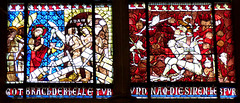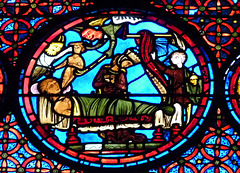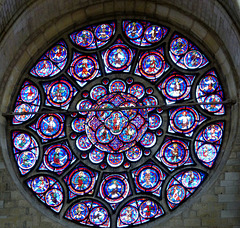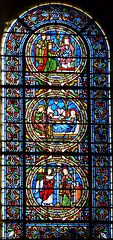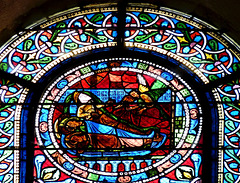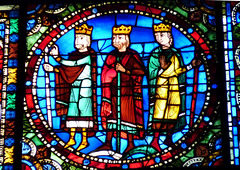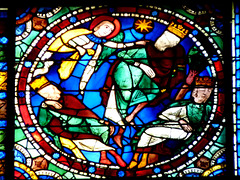
Stained Glass / Vitraux
Strasbourg - Cathédrale Notre-Dame
| |
|
|
When Strasbourg was first mentioned in 12BC, it was the Roman camp Argentoratum. Strasbourg was probably a bishop's seat from the 4th century. Alemanni, Huns and Franks conquered the city in the 5th century. Strasbourg was then ruled by the Strasbourg bishops until 1262 when the citizens violently rebelled against the bishopric and Strasbourg became a free imperial city and so belonged to the Holy Roman Empire. Led by two rival patrician families (Müllheim and Zorn), the city prospered, although the town hall required two separate entrances for the two families.
On February 14, 1349, one of the first and largest pogroms of persecution of Jews in connection with the plague in the German area took place here. In the course of the St. Valentine's Day massacre, several hundred (some say up to 3000) Jews were publicly burned, and the survivors were expelled from the city. Until the end of the 18th century, Jews were forbidden to stay within the city walls after 10 pm.
Strasbourg came under French rule in 1681, after the conquest of Alsace by the armies of Louis XIV. However, the revocation of the Edict of Toleration of Nantes in 1685, which legalized the suppression of Protestantism in France, did not apply in Alsace, and religious freedom prevailed, even if the French authorities endeavored to favor Catholicism wherever possible.
Strasbourg's Lutheran, German-influenced university continued to exist. Moreover, until 1789, Alsace was a de facto foreign province , separated from the rest of France by a customs border running along the Vosges Mountains. Therefore, the city and its surrounding area remained German-speaking. In the period of the French Revolution, the city became attractive for republicans from Germany and later an exile for German oppositionists.
The Strasbourg Cathedral (German: Straßburger Münster) was built between 1176 and 1439 on the site of a previous church from the early 11th century that had burned down to replace a church from the Carolingian period that had burned down in 1007. Gothic style. At least from 1647 to 1874, the cathedral with its 142-meter-high north tower was the tallest structure in human history and the tallest structure of the Middle Ages.
Important contributions from 1277 to his death in 1318 are attributed to the architect Erwin von Steinbach; he was succeeded by his son Johannes and his grandson Gerlach. The west facade was created by master Ulrich von Ensingen and his successor Johannes Hültz. With its characteristic asymmetrical shape (the south tower was never built), the Strasbourg Cathedral is the symbol of Alsace today.
The building was damaged by bombardments in 1870 and 1944. The figural decoration and the interior decoration were damaged in the course of the iconoclasm of the Reformation, the re-Catholicization in 1681 and the French Revolution.
Most of the stained glass windows are14th century, some late 12th century and 13th century.
The Magi
Strasbourg - Cathédrale Notre-Dame
| |
|
|
When Strasbourg was first mentioned in 12BC, it was the Roman camp Argentoratum. Strasbourg was probably a bishop's seat from the 4th century. Alemanni, Huns and Franks conquered the city in the 5th century. Strasbourg was then ruled by the Strasbourg bishops until 1262 when the citizens violently rebelled against the bishopric and Strasbourg became a free imperial city and so belonged to the Holy Roman Empire. Led by two rival patrician families (Müllheim and Zorn), the city prospered, although the town hall required two separate entrances for the two families.
On February 14, 1349, one of the first and largest pogroms of persecution of Jews in connection with the plague in the German area took place here. In the course of the St. Valentine's Day massacre, several hundred (some say up to 3000) Jews were publicly burned, and the survivors were expelled from the city. Until the end of the 18th century, Jews were forbidden to stay within the city walls after 10 pm.
Strasbourg came under French rule in 1681, after the conquest of Alsace by the armies of Louis XIV. However, the revocation of the Edict of Toleration of Nantes in 1685, which legalized the suppression of Protestantism in France, did not apply in Alsace, and religious freedom prevailed, even if the French authorities endeavored to favor Catholicism wherever possible.
Strasbourg's Lutheran, German-influenced university continued to exist. Moreover, until 1789, Alsace was a de facto foreign province , separated from the rest of France by a customs border running along the Vosges Mountains. Therefore, the city and its surrounding area remained German-speaking. In the period of the French Revolution, the city became attractive for republicans from Germany and later an exile for German oppositionists.
The Strasbourg Cathedral (German: Straßburger Münster) was built between 1176 and 1439 on the site of a previous church from the early 11th century that had burned down to replace a church from the Carolingian period that had burned down in 1007. Gothic style. At least from 1647 to 1874, the cathedral with its 142-meter-high north tower was the tallest structure in human history and the tallest structure of the Middle Ages.
Important contributions from 1277 to his death in 1318 are attributed to the architect Erwin von Steinbach; he was succeeded by his son Johannes and his grandson Gerlach. The west facade was created by master Ulrich von Ensingen and his successor Johannes Hültz. With its characteristic asymmetrical shape (the south tower was never built), the Strasbourg Cathedral is the symbol of Alsace today.
The building was damaged by bombardments in 1870 and 1944. The figural decoration and the interior decoration were damaged in the course of the iconoclasm of the Reformation, the re-Catholicization in 1681 and the French Revolution.
Most of the stained glass windows are14th century, some late 12th century and 13th century.
Christ's entry into Jerusalem and the Last Supper.
Strasbourg - Cathédrale Notre-Dame
| |
|
|
When Strasbourg was first mentioned in 12BC, it was the Roman camp Argentoratum. Strasbourg was probably a bishop's seat from the 4th century. Alemanni, Huns and Franks conquered the city in the 5th century. Strasbourg was then ruled by the Strasbourg bishops until 1262 when the citizens violently rebelled against the bishopric and Strasbourg became a free imperial city and so belonged to the Holy Roman Empire. Led by two rival patrician families (Müllheim and Zorn), the city prospered, although the town hall required two separate entrances for the two families.
On February 14, 1349, one of the first and largest pogroms of persecution of Jews in connection with the plague in the German area took place here. In the course of the St. Valentine's Day massacre, several hundred (some say up to 3000) Jews were publicly burned, and the survivors were expelled from the city. Until the end of the 18th century, Jews were forbidden to stay within the city walls after 10 pm.
Strasbourg came under French rule in 1681, after the conquest of Alsace by the armies of Louis XIV. However, the revocation of the Edict of Toleration of Nantes in 1685, which legalized the suppression of Protestantism in France, did not apply in Alsace, and religious freedom prevailed, even if the French authorities endeavored to favor Catholicism wherever possible.
Strasbourg's Lutheran, German-influenced university continued to exist. Moreover, until 1789, Alsace was a de facto foreign province , separated from the rest of France by a customs border running along the Vosges Mountains. Therefore, the city and its surrounding area remained German-speaking. In the period of the French Revolution, the city became attractive for republicans from Germany and later an exile for German oppositionists.
The Strasbourg Cathedral (German: Straßburger Münster) was built between 1176 and 1439 on the site of a previous church from the early 11th century that had burned down to replace a church from the Carolingian period that had burned down in 1007. Gothic style. At least from 1647 to 1874, the cathedral with its 142-meter-high north tower was the tallest structure in human history and the tallest structure of the Middle Ages.
Important contributions from 1277 to his death in 1318 are attributed to the architect Erwin von Steinbach; he was succeeded by his son Johannes and his grandson Gerlach. The west facade was created by master Ulrich von Ensingen and his successor Johannes Hültz. With its characteristic asymmetrical shape (the south tower was never built), the Strasbourg Cathedral is the symbol of Alsace today.
The building was damaged by bombardments in 1870 and 1944. The figural decoration and the interior decoration were damaged in the course of the iconoclasm of the Reformation, the re-Catholicization in 1681 and the French Revolution.
Most of the stained glass windows are14th century, some late 12th century and 13th century.
Harrowing Hell.
Jesus leads Adam and Eve out of hell, while Satan in tied.
Strasbourg - Cathédrale Notre-Dame
| |
|
|
|
When Strasbourg was first mentioned in 12BC, it was the Roman camp Argentoratum. Strasbourg was probably a bishop's seat from the 4th century. Alemanni, Huns and Franks conquered the city in the 5th century. Strasbourg was then ruled by the Strasbourg bishops until 1262 when the citizens violently rebelled against the bishopric and Strasbourg became a free imperial city and so belonged to the Holy Roman Empire. Led by two rival patrician families (Müllheim and Zorn), the city prospered, although the town hall required two separate entrances for the two families.
On February 14, 1349, one of the first and largest pogroms of persecution of Jews in connection with the plague in the German area took place here. In the course of the St. Valentine's Day massacre, several hundred (some say up to 3000) Jews were publicly burned, and the survivors were expelled from the city. Until the end of the 18th century, Jews were forbidden to stay within the city walls after 10 pm.
Strasbourg came under French rule in 1681, after the conquest of Alsace by the armies of Louis XIV. However, the revocation of the Edict of Toleration of Nantes in 1685, which legalized the suppression of Protestantism in France, did not apply in Alsace, and religious freedom prevailed, even if the French authorities endeavored to favor Catholicism wherever possible.
Strasbourg's Lutheran, German-influenced university continued to exist. Moreover, until 1789, Alsace was a de facto foreign province , separated from the rest of France by a customs border running along the Vosges Mountains. Therefore, the city and its surrounding area remained German-speaking. In the period of the French Revolution, the city became attractive for republicans from Germany and later an exile for German oppositionists.
The Strasbourg Cathedral (German: Straßburger Münster) was built between 1176 and 1439 on the site of a previous church from the early 11th century that had burned down to replace a church from the Carolingian period that had burned down in 1007. Gothic style. At least from 1647 to 1874, the cathedral with its 142-meter-high north tower was the tallest structure in human history and the tallest structure of the Middle Ages.
Important contributions from 1277 to his death in 1318 are attributed to the architect Erwin von Steinbach; he was succeeded by his son Johannes and his grandson Gerlach. The west facade was created by master Ulrich von Ensingen and his successor Johannes Hültz. With its characteristic asymmetrical shape (the south tower was never built), the Strasbourg Cathedral is the symbol of Alsace today.
The building was damaged by bombardments in 1870 and 1944. The figural decoration and the interior decoration were damaged in the course of the iconoclasm of the Reformation, the re-Catholicization in 1681 and the French Revolution.
Most of the stained glass windows are14th century, some late 12th century and 13th century
Bourges Cathedral
| |
|
|
The "Cathédrale Saint-Étienne de Bourges" was erected as a replacement for a 11th-century structure. The construction started probably in the last quarter of the 12th century, around the same time, when the builders and bricklayers started in Chartres. The choir of the cathedral was in use by 1214, the nave was finished 1255. The cathedral was consecrated in 1324.
With the completion of the choir of the cathedral , the first stained glass windows got installed. Most of the windows around the choir, created 1220/1230, survived the times. The wonderful "vitraux" here may even be a bit older than the more famous ones in Chartres.
Here is the Last Judgement.
The "Weighing of Souls" (Psychostasia) in the top part. In the center the the souls to the right are saved and move to Abraham, who holds the souls in a napkin on his bosom. Those souls to the right end in a hellmouth.
Bourges Cathedral
| |
|
|
The "Cathédrale Saint-Étienne de Bourges" was erected as a replacement for a 11th-century structure. The construction started probably in the last quarter of the 12th century, around the same time, when the builders and bricklayers started in Chartres. The choir of the cathedral was in use by 1214, the nave was finished 1255. The cathedral was consecrated in 1324.
With the completion of the choir of the cathedral , the first stained glass windows got installed. Most of the windows around the choir, created 1220/1230, survived the times. The wonderful "vitraux" here may even be a bit older than the more famous ones in Chartres.
The parable of the rich man and Lazarus
"HIC EST DIVES", the rich man is often named "Dives".
Luke 16 : 19-21
"There was a certain rich man who clothed himself in purple and fine linen, and who feasted luxuriously every day. At his gate lay a certain poor man named Lazarus who was covered with sores. Lazarus longed to eat the crumbs that fell from the rich man’s table. Instead, dogs would come and lick his sores."
Bourges Cathedral
| |
|
|
The "Cathédrale Saint-Étienne de Bourges" was erected as a replacement for a 11th-century structure. The construction started probably in the last quarter of the 12th century, around the same time, when the builders and bricklayers started in Chartres. The choir of the cathedral was in use by 1214, the nave was finished 1255. The cathedral was consecrated in 1324.
With the completion of the choir of the cathedral , the first stained glass windows got installed. Most of the windows around the choir, created 1220/1230, survived the times. The wonderful "vitraux" here may even be a bit older than the more famous ones in Chartres.
The parable of the rich man and Lazarus
Luke 16 : 22
"The poor man died and was carried by angels to Abraham’s side. The rich man also died and was buried."
The rich man´s soul leaves the body and is immidiatly grabbed by the devil. The fork, the right devil uses, can often be seen as an evil tool.
Laon - Cathedral
| |
|
|
|
In Laon, placed on a ridge and overlooking the flat Picardy plain, St. Remi founded a bishopric in 487. Laon was a very important place in the kingdom of the Franks.
A Carolingian cathedral, consecrated in 800 in the presence of Charlemagne, existed here. The Carolingian structure got replaced two centuries later by a Romanesque structure, consecrated in 1071.
This cathedral was torched by the citizens during the Easter Insurrection on 25 April 1112. Bishop Waldric (aka "Gaudry"), who had served as Lord Chancellor and Lord Keeper of England, from 1103 to 1107 (and described as greedy and very violent) was killed during the uproar. The cathedral got repaired, but in the end demolished to give room for the present cathedral.
The construction began about 1160. The nave was completed after 1205. The "Cathédrale Notre-Dame de Laon", towering over the town, is a wonderful, early example of the Gothic style that developed in Northern France.
Stained glass can be found in nearly all Gothic cathedrals in France. Techniques for the production of colored glass and for the manufacturing of large windows out of it, was fast developing during the 11 th century. This was a high-tech-industry with wonderful products. like the large rose-window of the choir.
Laon - Cathedral
| |
|
In Laon, placed on a ridge and overlooking the flat Picardy plain, St. Remi founded a bishopric in 487. Laon was a very important place in the kingdom of the Franks.
A Carolingian cathedral, consecrated in 800 in the presence of Charlemagne, existed here. The Carolingian structure got replaced two centuries later by a Romanesque structure, consecrated in 1071.
This cathedral was torched by the citizens during the Easter Insurrection on 25 April 1112. Bishop Waldric (aka "Gaudry"), who had served as Lord Chancellor and Lord Keeper of England, from 1103 to 1107 (and described as greedy and very violent) was killed during the uproar. The cathedral got repaired, but in the end demolished to give room for the present cathedral.
The construction began about 1160. The nave was completed after 1205. The "Cathédrale Notre-Dame de Laon", towering over the town, is a wonderful, early example of the Gothic style that developed in Northern France.
Stained glass can be found in nearly all Gothic cathedrals in France. Techniques for the production of colored glass and for the manufacturing of large windows out of it, was fast developing during the 11 th century. The dream of the Magi and the Magi travelling to Bethlehem. I'll upload more details photos next.
Laon - Cathedral
| |
|
In Laon, placed on a ridge and overlooking the flat Picardy plain, St. Remi founded a bishopric in 487. Laon was a very important place in the kingdom of the Franks.
A Carolingian cathedral, consecrated in 800 in the presence of Charlemagne, existed here. The Carolingian structure got replaced two centuries later by a Romanesque structure, consecrated in 1071.
This cathedral was torched by the citizens during the Easter Insurrection on 25 April 1112. Bishop Waldric (aka "Gaudry"), who had served as Lord Chancellor and Lord Keeper of England, from 1103 to 1107 (and described as greedy and very violent) was killed during the uproar. The cathedral got repaired, but in the end demolished to give room for the present cathedral.
The construction began about 1160. The nave was completed after 1205. The "Cathédrale Notre-Dame de Laon", towering over the town, is a wonderful, early example of the Gothic style that developed in Northern France.
Stained glass can be found in nearly all Gothic cathedrals in France. Techniques for the production of colored glass and for the manufacturing of large windows out of it, was fast developing during the 11 th century. The "Dream of the Magi". The angel awakes one of the Magi to tell him, not to return to Herod.
Laon - Cathedral
| |
|
In Laon, placed on a ridge and overlooking the flat Picardy plain, St. Remi founded a bishopric in 487. Laon was a very important place in the kingdom of the Franks.
A Carolingian cathedral, consecrated in 800 in the presence of Charlemagne, existed here. The Carolingian structure got replaced two centuries later by a Romanesque structure, consecrated in 1071.
This cathedral was torched by the citizens during the Easter Insurrection on 25 April 1112. Bishop Waldric (aka "Gaudry"), who had served as Lord Chancellor and Lord Keeper of England, from 1103 to 1107 (and described as greedy and very violent) was killed during the uproar. The cathedral got repaired, but in the end demolished to give room for the present cathedral.
The construction began about 1160. The nave was completed after 1205. The "Cathédrale Notre-Dame de Laon", towering over the town, is a wonderful, early example of the Gothic style that developed in Northern France.
Stained glass can be found in nearly all Gothic cathedrals in France. Techniques for the production of colored glass and for the manufacturing of large windows out of it, was fast developing during the 11 th century. The "Adoration of the Magi".
Le Mans - Saint-Julien du Mans
| |
|
|
An existing celtic settlement was conquered by the Romans 56bC and named Suindinum. Saint Julien du Mans, to whom the cathedral is dedicated, was the first bishop here upto 348. He was followed by Saint Liborius du Mans, who died here in 397 and was buried next to his predecessor inside the existing cathedral.
In 835 Saint Liborius´s relics were exhumed and - on order of Emperor Louis the Pious - transferred to Paderborn (900kms northeast), where Louis´ father Emperor Charlemagne had founded a diocese in 799. This young diocese suffered, as it had no saint of its own.
From this "translation" arose a "brotherhood" between Le Mans and Paderborn, considered to be the oldest "twinning contract" still in force.
The "Cathédrale Saint-Julien du Mans" was erected over a very long period. It has a Romanesque nave and a Gothic choir. The first nave of the cathedral was erected from 1100 on. Following a fire in 1134, a rebuilding programme was begun, following a different, more complex blueprint. This was partly funded by Henry II of England (aka "Henry Plantagenet", "Henry Curtmantle"), whose father, Geoffroy of Anjou (aka "the Handsome", "le Bel") was buried here in 1151.
The construction of the Gothic ambulatory choir started in 1217. The choir, that is about as long as the nave, was consecrated on April 24, 1254.
The oldest stained glass windows here date back to 1230/1240. Here are the Annunciation, the Nativity and the Adoration of the Magi.
Le Mans - Saint-Julien du Mans
| |
|
An existing celtic settlement was conquered by the Romans 56bC and named Suindinum. Saint Julien du Mans, to whom the cathedral is dedicated, was the first bishop here upto 348. He was followed by Saint Liborius du Mans, who died here in 397 and was buried next to his predecessor inside the existing cathedral.
In 835 Saint Liborius´s relics were exhumed and - on order of Emperor Louis the Pious - transferred to Paderborn (900kms northeast), where Louis´ father Emperor Charlemagne had founded a diocese in 799. This young diocese suffered, as it had no saint of its own.
From this "translation" arose a "brotherhood" between Le Mans and Paderborn, considered to be the oldest "twinning contract" still in force.
The "Cathédrale Saint-Julien du Mans" was erected over a very long period. It has a Romanesque nave and a Gothic choir. The first nave of the cathedral was erected from 1100 on. Following a fire in 1134, a rebuilding programme was begun, following a different, more complex blueprint. This was partly funded by Henry II of England (aka "Henry Plantagenet", "Henry Curtmantle"), whose father, Geoffroy of Anjou (aka "the Handsome", "le Bel") was buried here in 1151.
The construction of the Gothic ambulatory choir started in 1217. The choir, that is about as long as the nave, was consecrated on April 24, 1254.
The oldest stained glass windows here date back to 1230/1240. Here is the Adoration of the Magi (for an overview see previous upload).
Le Mans - Saint-Julien du Mans
| |
|
An existing celtic settlement was conquered by the Romans 56bC and named Suindinum. Saint Julien du Mans, to whom the cathedral is dedicated, was the first bishop here upto 348. He was followed by Saint Liborius du Mans, who died here in 397 and was buried next to his predecessor inside the existing cathedral.
In 835 Saint Liborius´s relics were exhumed and - on order of Emperor Louis the Pious - transferred to Paderborn (900kms northeast), where Louis´ father Emperor Charlemagne had founded a diocese in 799. This young diocese suffered, as it had no saint of its own.
From this "translation" arose a "brotherhood" between Le Mans and Paderborn, considered to be the oldest "twinning contract" still in force.
The "Cathédrale Saint-Julien du Mans" was erected over a very long period. It has a Romanesque nave and a Gothic choir. The first nave of the cathedral was erected from 1100 on. Following a fire in 1134, a rebuilding programme was begun, following a different, more complex blueprint. This was partly funded by Henry II of England (aka "Henry Plantagenet", "Henry Curtmantle"), whose father, Geoffroy of Anjou (aka "the Handsome", "le Bel") was buried here in 1151.
The construction of the Gothic ambulatory choir started in 1217. The choir, that is about as long as the nave, was consecrated on April 24, 1254.
The oldest stained glass windows here date back to 1230/1240. Here is the Dream of the Magi.
Chartres - Cathédrale Notre-Dame
| |
|
|
|
There have been five cathedrals on this site. One was destroyed by Visigothic troops mid of the 8th century. The successive cathedral was burnt down by Vikings ("Danes") in 858. The carolingian structure that was erected within the next decades was burnt down in 962 by troops led by Richard I of Normandy (aka "Richard the Fearless", "Richard Sans-Peur").
The rebuilding started again, but whatever was completed got destroyed by a fire, caused accidently, in 1020. The erection of a Romanesque cathedral started and most of the still existing crypt dates back to that building.
In 1134, another fire damaged the town and large parts of the cathedral. The towers got repaired and rebuilt and the portal between them got created. Another blaze hit the town in June 1194. The cathedral was burnt down. Construction works started the same year. The western towers and the undamaged western portal ("Portail Royal") got integrated into the new building.
The nave was already vaulted in 1220, the transept and the stained windows were completed in 1260. On 24 October 1260, only 66 years after the start of construction, the Cathédrale Notre-Dame was consecrated in the presence of Louis IX of France (aka "Saint Louis", "le Prudhomme").
Since Charles the Bald, Louis the Pious´ son, had given the "Sancta Camisia" to the cathedral in 876. Because of this "Veil of the Virgin" Chartres developed into a very important Marian pilgrimage center in medieval times.
The cathedral has been fortunate in being spared the damage suffered by so many during the Wars of Religion, the Revolution and even WWII. In 1939, just before the German army invaded France, all medieval galls windows were removed, so the 176 medieval windows stayed intact.
The oldest of these windows date back to ab 1150. They had been installed already the preceding cathedral, that burnt down. The most stained glass windows seen here were created between 1215 and 1240.
Here are the Magi. There is no star visible, so they are discussing where to go.
Chartres - Cathédrale Notre-Dame
| |
|
There have been five cathedrals on this site. One was destroyed by Visigothic troops mid of the 8th century. The successive cathedral was burnt down by Vikings ("Danes") in 858. The carolingian structure that was erected within the next decades was burnt down in 962 by troops led by Richard I of Normandy (aka "Richard the Fearless", "Richard Sans-Peur").
The rebuilding started again, but whatever was completed got destroyed by a fire, caused accidently, in 1020. The erection of a Romanesque cathedral started and most of the still existing crypt dates back to that building.
In 1134, another fire damaged the town and large parts of the cathedral. The towers got repaired and rebuilt and the portal between them got created. Another blaze hit the town in June 1194. The cathedral was burnt down. Construction works started the same year. The western towers and the undamaged western portal ("Portail Royal") got integrated into the new building.
The nave was already vaulted in 1220, the transept and the stained windows were completed in 1260. On 24 October 1260, only 66 years after the start of construction, the Cathédrale Notre-Dame was consecrated in the presence of Louis IX of France (aka "Saint Louis", "le Prudhomme").
Since Charles the Bald, Louis the Pious´ son, had given the "Sancta Camisia" to the cathedral in 876. Because of this "Veil of the Virgin" Chartres developed into a very important Marian pilgrimage center in medieval times.
The cathedral has been fortunate in being spared the damage suffered by so many during the Wars of Religion, the Revolution and even WWII. In 1939, just before the German army invaded France, all medieval galls windows were removed, so the 176 medieval windows stayed intact.
The oldest of these windows date back to ab 1150. They had been installed already the preceding cathedral, that burnt down. The most stained glass windows seen here were created between 1215 and 1240.
The Dream of the Magi.
The dreaming Magi are warned by an angel about the intentions of Herod.
Matthew 2:11-12
"On coming to the house, they saw the child with his mother Mary, and they bowed down and worshipped him. Then they opened their treasures and presented him with gifts of gold and of incense and of myrrh.
And having been warned in a dream not to go back to Herod, they returned to their country by another route"
Chartres - Cathédrale Notre-Dame
| |
|
|
|
There have been five cathedrals on this site. One was destroyed by Visigothic troops mid of the 8th century. The successive cathedral was burnt down by Vikings ("Danes") in 858. The carolingian structure that was erected within the next decades was burnt down in 962 by troops led by Richard I of Normandy (aka "Richard the Fearless", "Richard Sans-Peur").
The rebuilding started again, but whatever was completed got destroyed by a fire, caused accidently, in 1020. The erection of a Romanesque cathedral started and most of the still existing crypt dates back to that building.
In 1134, another fire damaged the town and large parts of the cathedral. The towers got repaired and rebuilt and the portal between them got created. Another blaze hit the town in June 1194. The cathedral was burnt down. Construction works started the same year. The western towers and the undamaged western portal ("Portail Royal") got integrated into the new building.
The nave was already vaulted in 1220, the transept and the stained windows were completed in 1260. On 24 October 1260, only 66 years after the start of construction, the Cathédrale Notre-Dame was consecrated in the presence of Louis IX of France (aka "Saint Louis", "le Prudhomme").
Since Charles the Bald, Louis the Pious´ son, had given the "Sancta Camisia" to the cathedral in 876. Because of this "Veil of the Virgin" Chartres developed into a very important Marian pilgrimage center in medieval times.
The cathedral has been fortunate in being spared the damage suffered by so many during the Wars of Religion, the Revolution and even WWII. In 1939, just before the German army invaded France, all medieval galls windows were removed, so the 176 medieval windows stayed intact.
The oldest of these windows date back to ab 1150. They had been installed already the preceding cathedral, that burnt down. The most stained glass windows seen here were created between 1215 and 1240.
The Nativity
Mary watches the baby in the manger. Joseph has fallen asleep. The Star of Bethlehem is already over the scene, three visitors are approaching the place.. .
Chartres - Cathédrale Notre-Dame
| |
|
|
There have been five cathedrals on this site. One was destroyed by Visigothic troops mid of the 8th century. The successive cathedral was burnt down by Vikings ("Danes") in 858. The carolingian structure that was erected within the next decades was burnt down in 962 by troops led by Richard I of Normandy (aka "Richard the Fearless", "Richard Sans-Peur").
The rebuilding started again, but whatever was completed got destroyed by a fire, caused accidently, in 1020. The erection of a Romanesque cathedral started and most of the still existing crypt dates back to that building.
In 1134, another fire damaged the town and large parts of the cathedral. The towers got repaired and rebuilt and the portal between them got created. Another blaze hit the town in June 1194. The cathedral was burnt down. Construction works started the same year. The western towers and the undamaged western portal ("Portail Royal") got integrated into the new building.
The nave was already vaulted in 1220, the transept and the stained windows were completed in 1260. On 24 October 1260, only 66 years after the start of construction, the Cathédrale Notre-Dame was consecrated in the presence of Louis IX of France (aka "Saint Louis", "le Prudhomme").
Since Charles the Bald, Louis the Pious´ son, had given the "Sancta Camisia" to the cathedral in 876. Because of this "Veil of the Virgin" Chartres developed into a very important Marian pilgrimage center in medieval times.
The cathedral has been fortunate in being spared the damage suffered by so many during the Wars of Religion, the Revolution and even WWII. In 1939, just before the German army invaded France, all medieval galls windows were removed, so the 176 medieval windows stayed intact.
The oldest of these windows date back to ab 1150. They had been installed already the preceding cathedral, that burnt down. The most stained glass windows seen here were created between 1215 and 1240.
The Adoration of the Magi
Matthew 2:11
"On coming to the house, they saw the child with his mother Mary, and they bowed down and worshipped him. Then they opened their treasures and presented him with gifts of gold and of incense and of myrrh."
Jump to top
RSS feed- Latest items - Subscribe to the latest items added to this album
- ipernity © 2007-2024
- Help & Contact
|
Club news
|
About ipernity
|
History |
ipernity Club & Prices |
Guide of good conduct
Donate | Group guidelines | Privacy policy | Terms of use | Statutes | In memoria -
Facebook
Twitter



